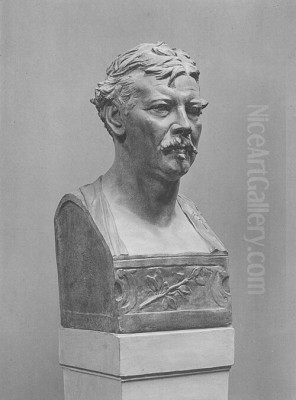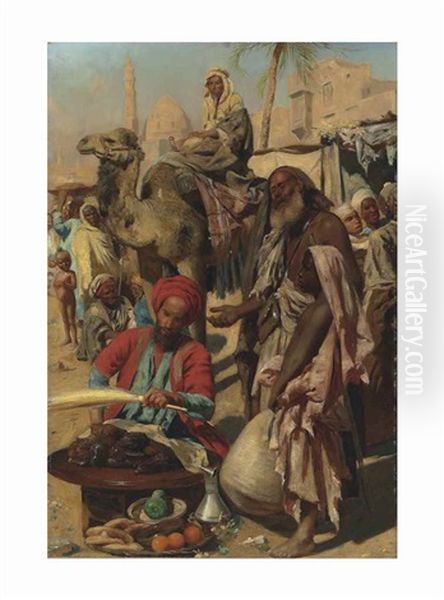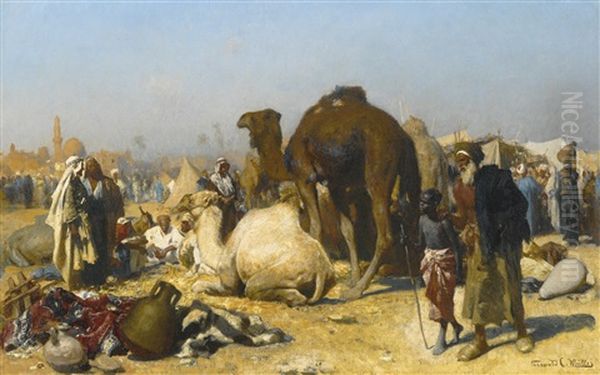
Leopold Carl Müller, often affectionately nicknamed "Orient-Müller," stands as one of Austria's most significant painters of the 19th century. Born in Dresden in 1834 and passing away in Vienna in 1892, Müller carved a distinct niche for himself within the European art world, becoming the preeminent Austrian exponent of Orientalism. His canvases, vibrant with the light, colour, and daily life of Egypt and the Near East, captivated audiences during his lifetime and continue to be celebrated for their technical brilliance and evocative power. His journey from a struggling student in Vienna to a respected professor and rector at the Academy of Fine Arts is a testament to his dedication and unique artistic vision, shaped profoundly by his extensive travels beyond the borders of Europe.
Early Life and Viennese Foundations
Leopold Carl Müller's artistic inclinations were perhaps inevitable. Born into an artistic milieu – his father was a lithographer in the Austrian army – young Leopold was exposed to the visual arts from an early age. The family relocated to Vienna, the imperial capital and a burgeoning centre for arts and culture. Tragedy struck early when his father passed away, leaving the family in precarious financial circumstances. This hardship spurred Müller's determination to pursue an artistic career, not just out of passion, but also out of necessity to support his family, including his sisters, Marie Müller, Bertha Müller, and Josefine Müller, who themselves would become painters.
His formal training began at the prestigious Vienna Academy of Fine Arts. Here, he studied under influential figures such as Karl von Blaas, known for his historical paintings, and Christian Ruben, who directed the Academy's historical painting school. These instructors provided Müller with a solid grounding in academic drawing, composition, and technique, skills that would underpin his later, more exotic subjects. During these formative years, financial pressures forced him to take on illustrative work, notably for the satirical magazine Vienna Figaro. While perhaps seen as a diversion from fine art, this work likely honed his observational skills and ability to capture character and narrative succinctly.
The Lure of Italy and the Call of the East

Like many artists of his generation, Müller felt the pull of Italy. Early travels took him to Venice and Rome, centres of Renaissance and Baroque art. These journeys exposed him to the masterpieces of the past and the unique light and atmosphere of the Mediterranean. While Italy offered inspiration, it was a different destination that would truly ignite his artistic imagination and define his career: Egypt. The growing European fascination with the "Orient" – a term encompassing North Africa, the Middle East, and sometimes further east – provided a compelling backdrop for artists seeking new subjects, colours, and experiences beyond the familiar European landscape.
Müller's first significant journey to Egypt occurred around 1873, a trip possibly undertaken with his contemporary, the flamboyant Viennese painter Hans Makart. This initial encounter was transformative. He was captivated by the intense sunlight, the vibrant colours of the markets, the diverse physiognomy of the people, and the remnants of ancient civilizations juxtaposed with contemporary life. This trip marked the beginning of a lifelong engagement with Egypt; he would return numerous times throughout the 1870s and 1880s, often spending extended periods, particularly during the winter months, sketching, observing, and gathering material.
His commitment to authenticity set him apart. Unlike some Orientalist painters who relied on studio props and imagination, Müller immersed himself in the environment. He travelled extensively within Egypt, visiting Cairo, Luxor, Aswan, and Nubia. He learned basic Arabic phrases to communicate, observed customs and rituals, and filled sketchbooks with detailed studies of people, architecture, animals, and landscapes. This dedication to firsthand experience infused his paintings with a sense of immediacy and realism that resonated with viewers back in Vienna.
Mastering Light and Colour: The Orientalist Style
Müller's artistic style evolved significantly following his Egyptian travels. He became a master of depicting the unique quality of North African light – the brilliant, almost blinding sunshine and the deep, contrasting shadows. His palette shifted, embracing warmer, more vibrant hues – ochres, reds, blues, and dazzling whites – to convey the intensity of the climate and the colourful textiles and wares of the region. He moved away from purely historical or mythological subjects towards genre scenes, capturing the everyday life of the streets, markets, and homes of Cairo and other locales.
His technique remained rooted in his academic training but adapted to his new subject matter. He employed fluid brushwork but maintained a high degree of detail, particularly in rendering textures, fabrics, and facial features. His compositions often feature bustling crowds, intricate architectural backdrops, and a strong sense of atmosphere. He excelled at capturing the human element, depicting individuals not merely as exotic types but with a sense of personality and dignity, whether portraying merchants, water carriers, scholars, or musicians.

Influences on his mature style can be traced. While grounded in Viennese tradition, his work shows an awareness of broader European trends. He admired the atmospheric depth of certain German painters like Arnold Böcklin and the idealism of Hans von Marées, whose works he encountered during his studies. His approach to Orientalist themes can be compared to prominent French painters like Jean-Léon Gérôme, known for his meticulous detail and dramatic scenes, or Eugène Fromentin, who also painted North African subjects with an emphasis on light and atmosphere. However, Müller developed a distinctly Austrian interpretation, often imbued with a certain warmth and less overt drama than some of his French counterparts.
Signature Works: Scenes from Egyptian Life
Among Müller's most celebrated works is Market in Cairo. This painting exemplifies his mature style. The canvas teems with life: merchants display their goods, potential buyers inspect wares, animals mingle with the crowd, and figures converse in the shade or move through the sun-drenched square. Müller masterfully orchestrates the complex scene, using light and shadow to guide the viewer's eye and create a sense of depth and bustling energy. The attention to detail in clothing, architecture, and individual expressions is remarkable, transporting the viewer directly into the heart of the Cairene marketplace.
Another significant work, The Camel Market, showcases his skill in depicting animals and the interplay between humans and their environment. The painting captures the dusty, lively atmosphere of a market dedicated to the "ships of the desert," highlighting the textures of the camels' hides and the varied attire of the traders. Works like Resting Caravan explore the theme of travel and repose under the desert sun, emphasizing the vastness of the landscape and the resilience of its inhabitants.
Paintings such as Nubian Well focus on specific activities and regional types, demonstrating his ethnographic interest. Cairene Rooftop offers a more intimate glimpse into urban life, perhaps depicting women in a more private setting, away from the public bustle of the streets. Across these and many other works, Müller consistently demonstrated his fascination with the visual richness of Egypt and his ability to translate his observations into compelling, light-filled compositions. His Brustbild eines Arabers (Bust of an Arab) highlights his skill in portraiture, capturing individual character with sensitivity.
Professor and Mentor: Shaping the Next Generation
Leopold Carl Müller's contributions extended beyond his own artistic output. In 1878, he was appointed professor at the Vienna Academy of Fine Arts, the very institution where he had trained. This prestigious position allowed him to pass on his knowledge and passion, particularly his expertise in Orientalist themes and techniques, to a new generation of Austrian artists. His studio at the Academy became a hub for students interested in depicting exotic locales and mastering the challenges of light and colour associated with such subjects.

His influence as a teacher was significant. While perhaps less famous internationally than Müller himself, students and followers like Charles Wilda and Franz Kosler continued the tradition of Austrian Orientalist painting, often travelling to Egypt and other parts of the Near East, inspired by their professor's example. Müller's teaching emphasized direct observation, solid draftsmanship, and the importance of capturing atmosphere, particularly the effects of light.
His standing within the Viennese art establishment grew throughout his career. He was an active member of the Vienna Künstlerhaus, the city's leading artists' association, regularly exhibiting his works there to critical acclaim. His success culminated in his appointment as Rector of the Academy of Fine Arts for the academic years 1890-1891, a position recognizing his artistic achievements and his leadership within the institution. This role, however, was sadly short-lived due to his declining health.
Context and Contemporaries: Vienna and Beyond
Müller worked during a vibrant period in Viennese art history, often referred to as the Ringstrassenära, characterized by grand architectural projects and a flourishing of the arts. He was a contemporary of Hans Makart, whose opulent historical and allegorical paintings dominated the Viennese scene for a time. While Müller shared Makart's interest in rich colour and texture, his focus on ethnographic realism and contemporary genre scenes offered a distinct alternative to Makart's often theatrical style.
His work also provides a fascinating contrast to slightly later developments in Viennese art, particularly the rise of the Secession movement led by figures like Gustav Klimt. While Müller remained largely committed to a form of academic realism, albeit applied to exotic subjects, Klimt and his circle would break away, exploring Symbolism, Art Nouveau, and more modern artistic languages. Yet, Müller's dedication to colour and decorative qualities in his detailed depictions perhaps subtly foreshadowed some of the aesthetic concerns of the later Secessionists.

Within the broader European context of Orientalism, Müller holds a significant place. He stands alongside British artists like John Frederick Lewis, who also spent considerable time living and working in Cairo, producing intricately detailed watercolours and oils of Egyptian life, and Lawrence Alma-Tadema, whose depictions of ancient Rome and Egypt, though more focused on historical reconstruction, shared an interest in archaeological detail and luxurious textures. Compared to the sometimes starker realism or dramatic narratives of French Orientalists like Gérôme, Müller's work often possesses a gentler, more picturesque quality. He was less concerned with political commentary or overt sensuality than some of his peers, focusing instead on the visual poetry of everyday life observed under the Egyptian sun. Another Austrian painter exploring different themes but contemporary was Anton Romako, known for his unconventional portraits and historical scenes. American artists like Frederick Arthur Bridgman also travelled extensively in North Africa, creating works that resonated with Müller's in their focus on light and local colour.
Legacy and Reception
Leopold Carl Müller enjoyed considerable success and recognition during his lifetime. His paintings were popular with collectors and the public, admired for their technical skill, vibrant colours, and evocative subject matter. His frequent travels and dedication to authenticity lent his work an air of authority and adventure that appealed to the 19th-century European imagination. His role as a professor and rector further solidified his esteemed position within the Austrian art world.
Today, Müller is remembered as the leading figure of Austrian Orientalism. His works are held in major collections, including the Belvedere Museum in Vienna, which houses a significant number of his paintings. While contemporary perspectives often involve critical reassessments of Orientalism, acknowledging its complex relationship with European colonialism and its tendency to exoticize or stereotype non-European cultures, Müller's artistic achievements remain undeniable. His mastery of light and colour, his detailed observation, and his ability to convey the atmosphere of the places he depicted secure his importance in 19th-century European art history.
His paintings continue to offer valuable visual records of Egyptian life in the late 19th century, filtered through the lens of a highly skilled European observer. They stand as testaments to a particular moment of cultural encounter, capturing the fascination that the "Orient" held for European artists and audiences, rendered with a technical brilliance and sensitivity that distinguishes Leopold Carl Müller's unique contribution to the art of his time.
Conclusion: An Enduring Vision of the East
Leopold Carl Müller, "Orient-Müller," remains a pivotal figure in Austrian art. His journey from Dresden to the heart of the Viennese art establishment, and his transformative travels to Egypt, shaped a unique and enduring artistic legacy. Through his vibrant canvases, filled with the dazzling light, rich colours, and detailed observations of Egyptian life, he not only defined Austrian Orientalism but also created a compelling body of work that continues to engage viewers. As a painter, professor, and rector, his dedication to his craft and his passion for capturing the essence of the East left an indelible mark, securing his place as one of the most accomplished and influential Austrian artists of the 19th century. His sunlit world, meticulously rendered, remains a captivating window onto another time and place.